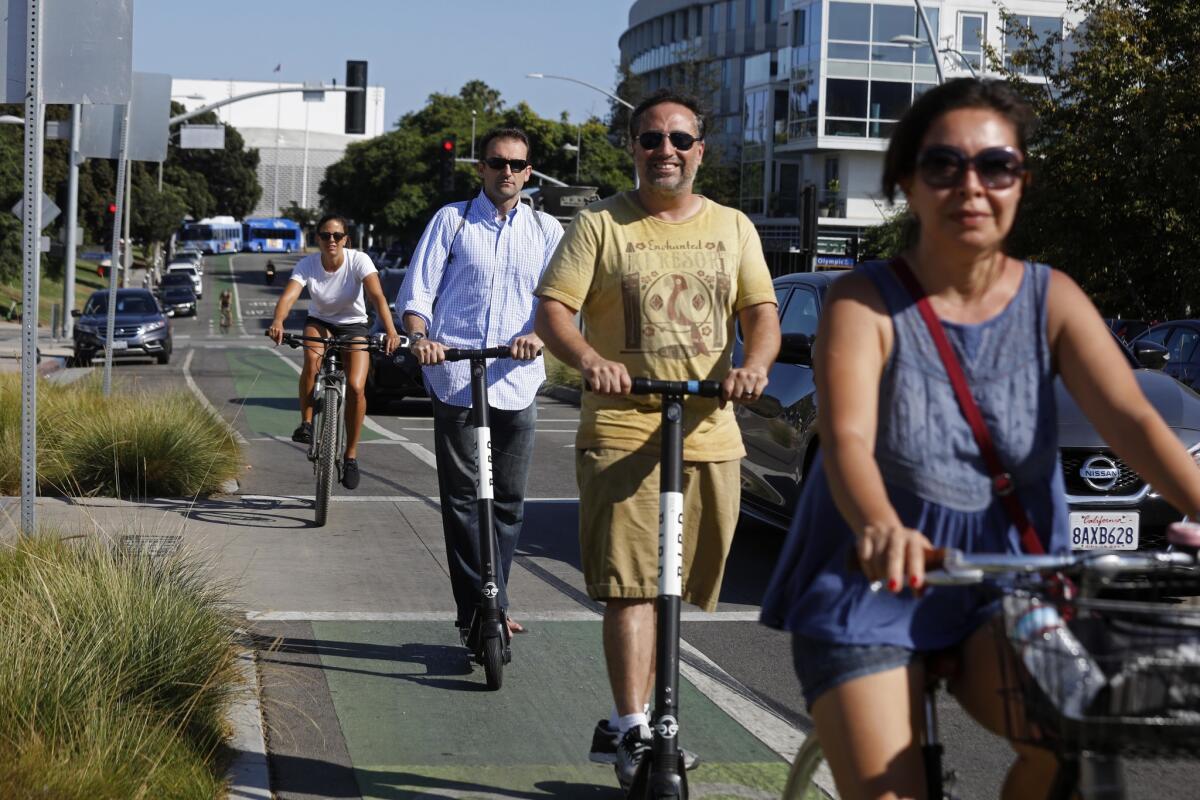Electric scooters are good for the environment, right? Here’s why it’s not so simple

In March, Joe Hollingsworth hopped on a Lime scooter and zipped across the campus of North Carolina State University. At the end of the ride, a message appeared on the screen: “Your ride was carbon free.”
The pronouncement embodied the climate-friendly marketing of e-scooter companies like Lime and Bird. But it puzzled Hollingsworth, then a graduate student in environmental engineering, and his advisor, Jeremiah Johnson.
Sure, scooters don’t have a tailpipe. “But you have to think about the other things that are required to have the scooter ready, charged and available for you to use,” Johnson said.
So he and his students decided to tally up the full environmental impact of electric scooters over their lifetimes. The results, published Friday in the journal Environmental Research Letters, suggest that e-scooters aren’t quite as eco-friendly as they may seem.
While traveling a mile by scooter is better than driving the same distance by car, it’s worse than biking, walking or taking a bus — the modes of transportation that scooters most often replace. That’s primarily because of the energy-intensive materials that go into making the vehicles, and because of the driving required to collect, charge, and redistribute them.
“That actual trip somebody’s taking on the scooter — that’s pretty green,” said Juan Matute, the deputy director of the UCLA Institute of Transportation Studies who was not involved with the study. “What’s not green is everything you don’t see.”
Dockless e-scooters, which you can unlock with an app and leave wherever you please, have flooded cities over the last year and half. In 2018 alone, people took 38.5 million scooter trips, according to the National Assn. of City Transportation Officials.
The technology is often touted as a solution to urban congestion and the vexing “last mile” problem — how to get people from their houses and offices to public transit lines. The proliferation of the two-wheeled devices has brought both joy and angst to urban residents, along with a fair number of fractured bones and head injuries, studies have shown. But until now, researchers had not conducted a rigorous analysis of the companies’ sustainability claims.
So Johnson and his students purchased a Xiaomi M365 scooter, which was used for the first generation of Birds, and took it apart. They made precise measurements of each component’s weight and calculated the greenhouse gas emissions associated with making it. They also looked at the resulting air and water pollution.
Those impacts were significant, the researchers found, especially for the scooter’s 13-pound aluminum frame and its 2-pound lithium ion battery. Using their best estimates about scooter use and management in Raleigh, N.C., they found that materials and manufacturing accounted for roughly half of its global warming impact and an even greater proportion of its other pollution footprints.
Those results depend heavily on scooter longevity, which influences how many rides companies can get out of those parts. And urban life is hard on shared e-scooters.
They succumb to the everyday wear and tear of riding and recharging. There’s also rampant vandalism. People trash scooters for all sorts of reasons — for fun, out of frustration that they’ve taken over bike lanes and sidewalks, and because many are sick of the kinds of tech start-ups behind them. (In Southern California, scooters have been burned, broken and buried at sea.)
By some estimates, Bird’s first batch of scooters lasted about three to four months, and the newer Bird Zeros are said to make it about 10 months. However, one analysis by Quartz found that scooters in Louisville, Ky., only survived an average of 29 days.
If such short lifetimes are typical, it would boost the true impact of materials and manufacturing above the researchers’ estimates, Johnson said. He and his colleagues assumed the scooters operated for at least six months.
And “even when we’re generous, it still looks pretty bad,” said Matt Chester, an energy analyst at Chester Energy and Policy who published a back-of-the-envelope life cycle assessment of e-scooters that reached broadly similar conclusions.

The other big environmental cost associated with scooters comes from the laborious process of collecting, charging and redeploying them each night.
Lime and Bird farm out the job to independent contractors who get paid by the scooter. Sometimes, you see cars piled high with spent two-wheelers. But often, Johnson said, competition forces people to travel farther to round up fewer vehicles, which adds to their environmental impact.
“I see people driving around picking up these scooters all the time,” Chester said. “Maybe it’s still a net positive, but it can’t be as good as they say.”
Based on their estimates for Raleigh, Johnson and his colleagues found that the nightly collection and redistribution of scooters accounted for 43% of their overall global warming impact. Electricity for charging the scooters represented just 5%, and shipping even less.
The researchers considered a wide range of factors that could make the overall footprint of scooters bigger or smaller. But they found that 65% of the time, scooters were worse than what they replaced.
In their baseline case, they found that riding one mile on a scooter produced the equivalent of 202 grams of carbon dioxide. That’s much less than a car (which emits 414 g of CO2 per mile), but more than riding a moped (119 g), taking a bus (82 g), biking (8 g) or walking (0 g).
Without scooters, users would have opted for a mixture of these options. When Johnson and his students surveyed 61 scooter users in Raleigh, half of them said they’d have walked or biked, and 11% would have taken a bus. A third of them would have gone by car (either their own or using a ride-hailing service). The other 7% would not have made the trip at all. (These responses square with the results of a larger poll conducted by the city of Portland, Ore., in 2018.)
That blend of alternatives would produce emissions of about 150 g of CO2 per mile, the researchers estimated. However, Johnson cautioned that these figures could change under different circumstances.
“These aren’t static, immutable numbers,” he said. “These are a snapshot in time.”
Scooters could come out on top in cities where a larger fraction of riders used them as a substitute for driving. And there are ways to reduce the environmental impacts.
For instance, the study authors recommend that companies and cities take steps to increase scooter lifetime, like enacting and enforcing anti-vandalism policies. They also suggest streamlining the collection process, perhaps by having companies do it themselves using fuel-efficient (or electric) vehicles. And not every scooter needs to be picked up. About one in six scooters in Raleigh still had a full charge at the end of the day.
Chester said he has also heard of other companies experimenting with options like swapping out the batteries rather than transporting entire scooters.
One simple solution to both vandalism and charging would be to store scooters at powered docking stations, like many bike sharing programs. But that would fundamentally change the industry’s hop on, hop off business model, Matute said.
When asked about the study, both Bird and Lime reiterated their commitment to sustainability.
A spokesperson for Lime said the company welcomed the new research, but added that the study is “largely based on assumptions and incomplete data that produces high variability in the results.”
The spokesperson also noted that Lime is working to address many of the issues highlighted in the report. For instance, Lime allows so-called juicers to make advance claims on the scooters they plan to charge to avoid having multiple people drive to the same one. The company also discourages people from picking up vehicles that don’t need power.
Lime and Bird already buy clean energy or carbon offsets to compensate for the emissions associated with charging their scooters (though not to cover their collection, redistribution or manufacturing). They’re also deploying hardier scooter models that they hope will last more than a year and repairing vehicles as much as possible.
Melinda Hanson, Bird’s head of sustainability, said the company is confident that its scooters can play a role in combating climate change. “We can only hope that other transportation providers similarly consider their own environmental impact and help do what is necessary to address this crisis,” she said.






